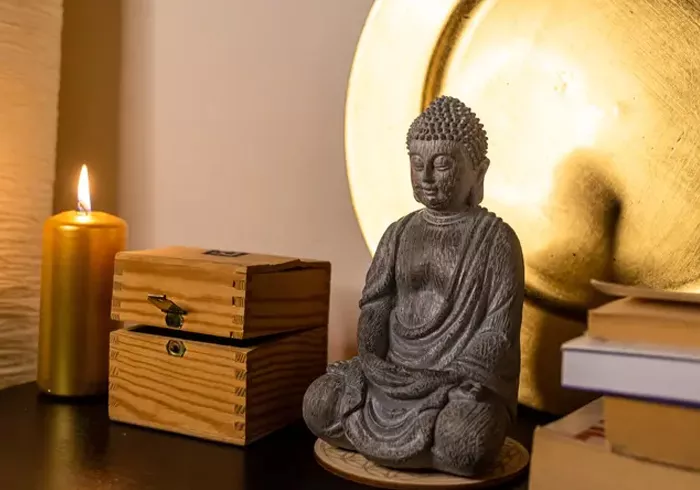Chinese Buddha statues are more than mere artistic creations; they are profound symbols of Buddhist teachings, embodying deep spiritual meanings and cultural significance. These statues serve as visual representations of the Buddha’s life, his enlightenment, and the path to liberation from suffering. Understanding the meanings behind these statues offers insight into Chinese Buddhism and its rich artistic heritage.
Origins of Chinese Buddhist Sculpture
Buddhism was introduced to China from India over 2,000 years ago, during the Han Dynasty.
As Buddhism took root, it influenced various aspects of Chinese culture, including art. Chinese Buddhist sculptures evolved, blending Indian influences with indigenous Chinese artistic styles.
Initially, Buddhist art in China began with symbolic representations such as empty seats, footprints, trees, or stupas.
Over time, these evolved into more anthropomorphic depictions of the Buddha, reflecting both Indian prototypes and unique Chinese interpretations.
Common Poses and Their Symbolism
The posture and gestures of Buddha statues are deliberate and carry specific meanings. Each pose, known as a “mudra,” represents different aspects of the Buddha’s teachings and life events.
1. Seated Buddha (Meditation Pose)
The most common representation is the seated Buddha, depicted in a cross-legged position with hands resting in the lap. This pose signifies meditation and enlightenment, embodying the Buddha’s deep contemplation under the Bodhi tree.
2. Standing Buddha
Standing Buddha statues often depict the Buddha with one hand raised in a gesture of reassurance and the other holding a teaching gesture. This pose represents the Buddha’s role as a teacher and protector, guiding beings toward enlightenment.
3. Reclining Buddha
The reclining Buddha, shown lying on his side, symbolizes the Buddha’s entry into Nirvana, marking the end of his earthly existence and his final liberation from the cycle of rebirth.
4. Walking Buddha
Less common but significant, the walking Buddha is depicted in motion, symbolizing the Buddha’s journey through life and his teachings as he traveled to spread wisdom.
Hand Gestures (Mudras) and Their Meanings
The hand gestures, or mudras, of Buddha statues are integral to their symbolism, each conveying specific teachings and aspects of the Buddha’s life.
1. Dharmachakra Mudra (Teaching Gesture)
This mudra features the Buddha’s hands held at chest level, with the thumb and index finger forming a circle. It represents the turning of the Wheel of Dharma, symbolizing the Buddha’s role in teaching the path to enlightenment.
2. Abhaya Mudra (Gesture of Fearlessness)
In this gesture, the right hand is raised to shoulder height with the palm facing outward, symbolizing protection, peace, and the dispelling of fear. It reassures devotees of the Buddha’s protection and guidance.
3. Vitarka Mudra (Gesture of Discussion)
Here, the thumb and index finger form a circle at chest level, with the other fingers extended. This mudra signifies the transmission of Buddhist teachings and the importance of scholarly discussion in understanding the Dharma.
4. Varada Mudra (Gesture of Generosity)
The right hand is extended downward with the palm facing outward in this gesture, symbolizing compassion, charity, and the granting of wishes. It reflects the Buddha’s willingness to help all beings.
Cultural Significance and Artistic Evolution
Chinese Buddha statues are not only religious symbols but also reflect the cultural and artistic evolution of Chinese society.
Influence of Dynastic Eras
Throughout different dynastic periods, the style and representation of Buddha statues evolved. For instance, during the Tang Dynasty, sculptures became more dignified and robust, reflecting the empire’s prosperity and cosmopolitan culture.
Regional Variations
China’s vast geography and diverse ethnic groups have led to regional variations in Buddhist art. In regions influenced by Tibetan Buddhism, such as parts of Sichuan and Qinghai, statues often feature vibrant colors and intricate details. In contrast, statues in southern China may exhibit more subdued tones and simpler forms.
The Laughing Buddha (Budai)
Beyond representations of Siddhartha Gautama, Chinese Buddhism also venerates the Laughing Buddha, known as Budai. Often depicted as a rotund, smiling monk with a large belly, Budai symbolizes contentment, abundance, and happiness. He is considered a protector of children and a bringer of good fortune.
Modern Interpretations and Global Influence
In contemporary times, Chinese Buddha statues have transcended their religious origins, influencing global art and design. They are often used in interior decor to evoke a sense of peace and serenity. However, it’s essential to approach these symbols with respect for their cultural and religious significance.
Conclusion
Chinese Buddha statues are rich in symbolism, reflecting the teachings of Buddhism and the cultural heritage of China. Each pose, gesture, and artistic style carries profound meaning, offering insights into the path to enlightenment and the values of compassion, wisdom, and peace. By understanding these symbols, we gain a deeper appreciation for the spiritual and artistic traditions that have shaped Chinese society over centuries.

